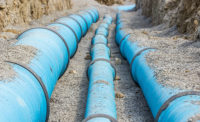Much of the United States’ more than one million miles of pipe is coming to the end of its useful life. The deteriorating condition of the country’s water infrastructure cannot be denied, with some cities using water pipe installed before the Civil War and others still using wooden pipe. While these may be extreme examples, the American Water Works Association (AWWA) has called for the U.S. aging water infrastructure to enter a “replacement era.”
CIPP offers a solution
One option to address the need for replacement is the use of cured-in-place pipe, or CIPP. This is a resin-impregnated tube used to line existing pipe.
The lining of existing pipe is performed using trenchless technology, meaning it can be done without the need for extensive digging. The main advantage of trenchless installation of CIPP liners is service lines can more quickly be put back into commission at a lower cost than could be achieved by traditional repair or replacement methods.
CIPP pipe liners can consist of a variety of materials, but are generally installed the same way. A felt tube comprised of polyethylene, fiberglass or other material is impregnated with resin at the product manufacturing facility. These resins are typically epoxy, vinyl ester or polyester, and include a chemical catalyst or hardener to facilitate curing. The resin-impregnated liner is then transported to the installation site, often under refrigerated conditions to prevent the resin from curing prematurely. The section of pipe to be repaired will have been taken out of service and thoroughly cleaned in preparation for the installation of the liner.
Most CIPP liners are installed using an inversion method, where a scaffold tower or pressure vessel is used to apply air or water pressure to turn the liner inside out as it is pushed along the length of the host pipe. Alternately, some CIPP liners are installed by winching into place through an access site and then inflated to fill the circumference of the host pipe.
Although the resin-impregnated liner will typically cure at a slow rate under ambient temperature, the cure is usually accelerated by flowing hot water or steam through the liner or by pulling a UV light train through the liner. Following the cure, the ends of the liner are trimmed and sealed flush with the pipe ends, and the rehabilitated pipe is inspected before bringing the repaired section of pipe back into service.
CIPP certification
CIPP liners may be certified to NSF/ANSI/CAN 61 for potable water applications or to NSF/ANSI 14 for drain, waste and vent applications. Certification to either standard requires a complete initial audit of the manufacturing facility and testing of the product, followed by regular auditing and testing cycles to ensure continued compliance of the product to the applicable standard(s).
Certification of a CIPP liner to NSF/ANSI/CAN 61 entails a complete review of the product’s formulation down to the single-chemical level. This information is used to create a specialized test battery that will be used to test for any contaminants that may leach from the product into the drinking water supply. Once the testing is ready to be performed, the product manufacturer installs and cures its product within a short section of host pipe, using the same methods that would be used in a field installation. This test section of pipe is shipped to NSF International laboratories, where it undergoes leachate testing according to the requirements of NSF/ANSI/CAN 61. The resulting test water is analyzed for contaminants that may have leached from the CIPP liner being tested and the level of each contaminant is quantified. All contaminants must be present at levels below the health effects criteria of NSF/ANSI/CAN 600 to pass the test required to achieve certification to NSF/ANSI/CAN 61.
NSF/ANSI 14 certifies CIPP liners to the performance requirements of ASTM F1216: Standard Practice for Rehabilitation of Existing Pipelines and Conduits by the Inversion and Curing of a Resin-Impregnated Tube for drain, waste and vent applications. Performance tests include flex modulus, flexural strength and gravity pipe leakage. Flex modulus and flexural strength tests determine the ability of the CIPP liner to withstand the pressure and external load experienced by buried pipe. Gravity pipe leakage testing is an exfiltration test that measures water penetration from the CIPP liner. CIPP liners listed to NSF/ANSI 14 are tested to these performance requirements for initial certification and on an annual basis, ensuring continued compliance to ASTM F1216.



